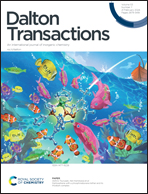ATRP catalysts of tetradentate guanidine ligands – do guanidine donors induce a faster atom transfer?†‡
Abstract
Tripodal tetradentate N donor ligands stabilise the most active ATRP catalyst systems. Here, we set out to synthesise the new guanidine ligand TMG-4NMe2uns-penp, inspired by p-substituted tris(2-pyridylmethyl)amine (TPMA) ligands. The impact of changing pyridine against guanidine donors was examined through solid state and solution experiments and density functional theory (DFT) calculations. In the solid state, the molecular structures of copper complexes based on the ligands TMG-4NMe2uns-penp, TMG-uns-penp and TMG3tren were discussed concerning the influence of a NMe2 substituent at the pyridines and the guanidine donors. In solution, the TMG-4NMe2uns-penp system was investigated by several methods, including UV/Vis, EPR and NMR spectroscopy indicating similar properties to that of the highly active TPMANMe2 system. The redox potentials were determined and related to the catalytic activity. Besides the expected trends between these and the ligand structures, there is evidence that guanidine donors in tripodal ligand systems lead to a better deactivation and possibly a faster exchange within the ATRP equilibrium than TPMA systems. Supported by DFT calculations, it derives from an easier cleavable Cu–Br bond of the copper(II) deactivator species. The high activity was stated by a controlled initiator for continuous activator regeneration (ICAR) ATRP of styrene.



 Please wait while we load your content...
Please wait while we load your content...